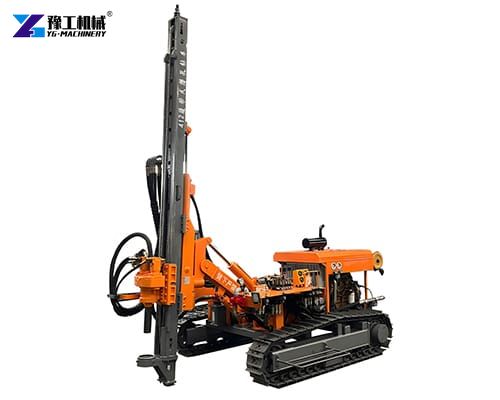Down the hole drilling rig is a specialized piece of equipment designed to drill deep holes into the earth’s surface. DTH drilling utilizes a hammer mechanism that delivers powerful, rapid blows to the drill bit, enabling it to penetrate even the toughest rock formations. This method is particularly effective in hard rock drilling. It is ideal for mining, quarrying, water wells, and geotechnical projects. DTH rigs reduce operational costs while maximizing productivity.
Components of a Down the Hole Drilling Rig
- Drill Rig Frame: The sturdy frame provides support and stability to the entire drilling system, ensuring accurate and safe operation.
- Rotary Head: This component rotates the drill string, which includes the drill rods and bit, facilitating the drilling process.
- Down the Hole Hammer: The heart of the DTH drilling rig, the hammer delivers high-frequency impacts to the drill bit, breaking up the rock and advancing the hole.
- Drill Bit: Available in various shapes and sizes, the drill bit is designed to suit specific drilling conditions and rock types.
- Feed System: The feed system controls the movement of the drill string, allowing for precise control over the drilling depth and speed.
- Control Panel: The control panel enables operators to monitor and adjust various drilling parameters, ensuring optimal performance.
Applications of Down the Hole Drilling Machine
Down the hole drilling rigs are versatile machines that find applications in a wide range of industries and projects. Some of the most common applications include:
Mining: DTH drilling rigs are extensively used in mining operations to extract minerals such as gold, copper, and iron ore. Their ability to drill deep holes in hard rock formations makes them ideal for this purpose.
Construction: In construction projects, DTH drilling rigs are used to create foundations for buildings, bridges, and other structures. They can also be used for soil nailing and slope stabilization.
Geotechnical Engineering: Geotechnical engineers rely on DTH drilling rigs to conduct soil and rock sampling, as well as to install monitoring instruments for assessing ground stability and potential hazards.
Choosing the Right DTH Drilling Rig
Selecting the right down the hole drilling rig for your project is crucial to ensuring success and efficiency. Here are some key factors to consider when making your decision:
Drilling Depth: Determine the maximum depth you need to drill and choose a rig with sufficient capacity to handle it.
Rock Type: Consider the type of rock you’ll be drilling into. Different rock types require different drill bits and hammer configurations for optimal performance.
Portability: If your project requires mobility, look for a rig that is easy to transport and set up at different locations.
Power Source: Decide whether you need a diesel-powered or electric-powered rig based on your project’s requirements and availability of power sources.
Budget: Set a budget for your drilling rig and look for options that offer the best value for money without compromising on quality or performance.


